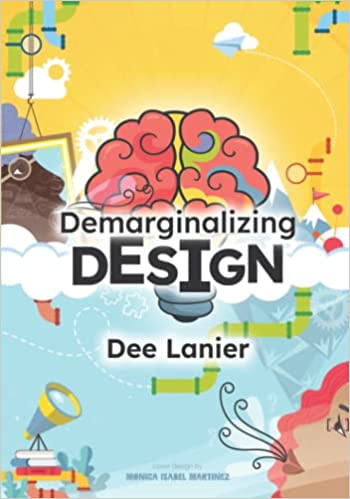
This post is written by Dee Lanier, an Educational Technologist and Equity Enthusiast. Dee is an award winning presenter, TEDx Speaker, Google Certified Trainer, Google Innovator, and Google Certified Coach. Dee is also the creator of the gamified design thinking activity called Solve in Time!®️ and the author of Demarginalizing Design. You can connect with Dee on Twitter @deelanier.
In 2020 I began writing the book, Demarginalizing Design out of an urgent desire to combat myths about design thinking, racial equity work, and community engagement in schools. The overall intensity of that year caused me to slow down and take my take and write at a more breathable pace. Two years later a final manuscript was formed and I released it to the public.
Here are what I hope are some helpful tidbits to help you understand the tenets of demarginalizing design:

What do you know about design thinking?
In the education space, it is likely that you have been introduced to one of the two more popularized models for design thinking: IDEO’s model which was established in 1978, and Stanford d.school’s model originally established in 2005. Let me set the record straight, I have no problem with either of these models if understood and used with the right perspective. Design thinking is first and foremost, thinking. Or, thinking like a designer. In short, designers think like problem-solvers and take a systematic approach to answer questions and propose solutions to problems that affect people.
The model a designer uses is simply a process that is helpful to come up with a solution to a problem. If you are familiar with one design thinking process, please note that there are several more in existence, some more popular than others, and all borrowing insights from other peoples and cultures and formulaic thinking. Consider how a five-paragraph essay is simply a multi-point process with a clear starting place and end goal. Same with the scientific method or the engineering process. All of these methods are utilized to help the participants think, in order to solve. They are helpful, but in a sense, they are not new or revolutionary.
Without a doubt, the ancient civilizations of the Egyptians and Mayans utilized a systematic approach in figuring out how to create elaborate irrigation systems and construct pyramids and develop highly accurate calendars. Two different civilizations separated by hundreds of miles and millennia display the common characteristics of design thinking: that is, thinking like a designer. To demarginalize design is to consider the contributions of many, not just the most recent or popularized name given attribution.
How do you demarginalize design?
To demarginalize design is to call in the people most proximate to the problem to co-design solutions to the problems that directly affect them. Remember that, people over process. Additionally, to demarginalize design is to recognize the limits of empathy (due to personal privileges and biases) and instead start with equity. Start with empathy and you may very well miss equity. Start with equity and you will also achieve empathy. It’s a package deal.
Get proximate to the pain

- Gather the people that are most affected by the problem.
- Listen for pain. Emotions such as outrage and frustration are insights into the source of the problem.
- Design with them, not for them. Your job is to facilitate the discussion that allows them to come up with their own solutions that affect their community.
Pursue deep humility

- Position and posture yourself as a learner, not an expert.
- Part of your learning is noticing the power you hold, the privileges afforded to you (socially, in general, and specific to the context you are in) and to notice your own bias towards the people you are problem-solving with.
- Credit the community for the solutions offered, not yourself.
Show an insatiable curiosity

- Ask open-ended questions such as, “How does that make you feel?” In comparison to, “Does that make you feel angry?”
- Remember the “3 Before Me Rule?” This also works for understanding a problem better. Try formulating at least three different Who, What, When, Where, Why, or How questions before offering any suggestions.
- Dig deeper into the things you do not understand. A helpful technique here is to ask, “Five Whys” when someone or a group expresses a problem. It may feel obnoxious but can really dig out the core of the issue by asking, “Why is that a problem?.. So why is that a problem?... And why is that a problem?.. And why is that a problem?... Why is that a problem?”
If many of these concepts are new to you, it’s ok to slow down and learn at a breathable pace. I would love to be a part of your journey as you look to demarginalize design.

Where can you learn more?
- Purchase Demarginalizing Design from Amazon.
- Interact with me on Twitter @deelanier.
- Also, check out my gamified design thinking activity called, Solve in Time!



Amazing post. thanks.
Good learning experience !